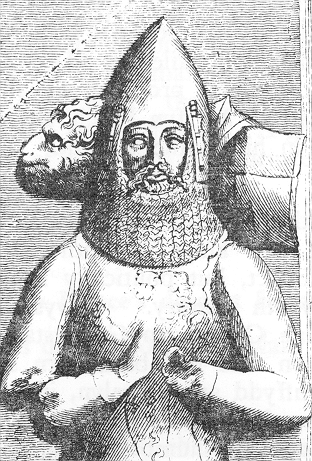
Rhys ap Gruffydd or ap Gruffudd was the ruler of the kingdom of Deheubarth in south Wales from 1155 to 1197. Today, he is commonly known as The Lord Rhys, in Welsh Yr Arglwydd Rhys, although this title may have not been used in his lifetime. He usually used the title "Proprietary Prince of Deheubarth" or "Prince of South Wales", but two documents have been discovered in which he uses the title "Prince of Wales" or "Prince of the Welsh". Rhys was one of the most successful and powerful Welsh princes, and, after the death of Owain Gwynedd of Gwynedd in 1170, the dominant power in Wales.
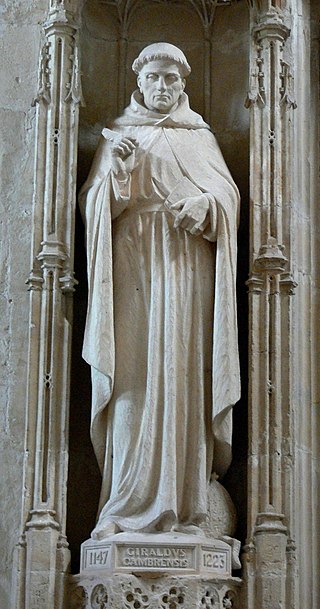
Gerald of Wales was a Cambro-Norman priest and historian. As a royal clerk to the king and two archbishops, he travelled widely and wrote extensively. He studied and taught in France and visited Rome several times, meeting the Pope. He was nominated for several bishoprics but turned them down in the hope of becoming Bishop of St Davids, but was unsuccessful despite considerable support. His final post was as Archdeacon of Brecon, from which he retired to academic study for the remainder of his life. Much of his writing survives.

The white-throated dipper, also known as the European dipper or just dipper, is an aquatic passerine bird found in Europe, Middle East, Central Asia and the Indian Subcontinent. The species is divided into several subspecies, based primarily on colour differences, particularly of the pectoral band.

The barnacle goose is a species of goose that belongs to the genus Branta of black geese, which contains species with largely black plumage, distinguishing them from the grey Anser species. Despite its superficial similarity to the brant goose, genetic analysis has shown it is an eastern derivative of the cackling goose lineage.
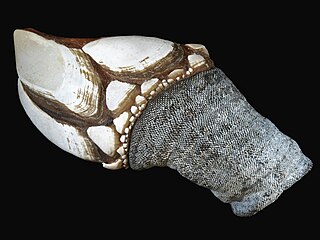
Goose barnacles, also called stalked barnacles or gooseneck barnacles, are filter-feeding crustaceans that live attached to hard surfaces of rocks and flotsam in the ocean intertidal zone. Goose barnacles formerly made up the taxonomic order Pedunculata, but the group has been found to be polyphyletic, with its members scattered across multiple orders of the infraclass Thoracica.
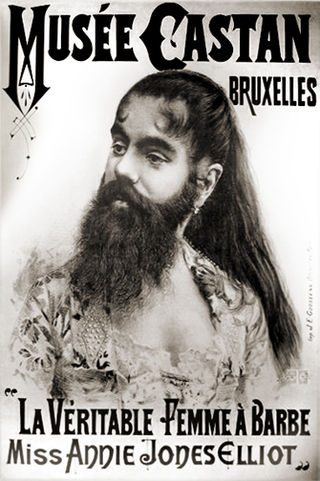
A bearded lady is a woman with a naturally occurring beard normally due to the condition known as hirsutism or hypertrichosis. Hypertrichosis causes people of either sex to develop excess hair over their entire body, while hirsutism is restricted to females and only causes excessive hair growth in the nine body areas mentioned by Ferriman and Gallwey.
Dafydd ab Owain Gwynedd was Prince of Gwynedd from 1170 to 1195. For a time he ruled jointly with his brothers Maelgwn ab Owain Gwynedd and Rhodri ab Owain Gwynedd.

Tighearnán Mór Ua Ruairc, anglicised as Tiernan O'Rourke ruled the kingdom of Breifne as the 19th king in its Ua Ruairc dynasty, a branch of the Uí Briúin. As one of the provincial kings in Ireland in the twelfth century, he constantly expanded his kingdom through shifting alliances, of which the most long-standing was with Toirdelbach Ua Conchobair King of Connacht and High King of Ireland, and subsequently his son and successor Ruaidhrí Ua Conchobair. He is known for his role in the expulsion of Diarmait Mac Murchada, King of Leinster, from Ireland in 1166. Mac Murchada's subsequent recruitment of Marcher Lords to assist him in the recovery of his Kingdom of Leinster ultimately led to the Norman invasion of Ireland.

Laudabiliter was a bull issued in 1155 by Pope Adrian IV, the only Englishman to have served in that office. Existence of the bull has been disputed by scholars over the centuries; no copy is extant but scholars cite the many references to it as early as the 13th century to support the validity of its existence. The bull purports to grant the right to the Angevin King Henry II of England to invade and govern Ireland and to enforce the Gregorian Reforms on the semi-autonomous Christian Church in Ireland. Richard de Clare ("Strongbow") and the other leaders of the Anglo-Norman invasion of Ireland (1169–71) claimed that Laudabiliter authorised the invasion. These Cambro-Norman knights were retained by Diarmuid MacMorrough, the deposed King of Leinster, as an ally in his fight with the High King of Ireland, Ruaidrí Ua Conchobair.
Turgesius was a Viking chief active in Ireland during the 9th century. Turgesius Island, the principal island on Lough Lene, is named after him. It is not at all clear whether the names in the Irish annals represent the Old Norse Thurgestr or Thorgísl. John O'Donovan and Charles Haliday independently identified him with Ragnar Loðbrók, but the identification is not generally accepted.
Events from the year 1185 in Ireland.
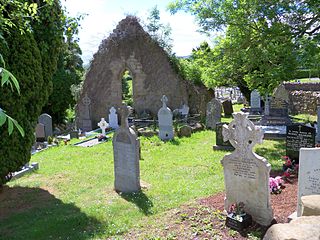
Natalis was a 6th-century Irish monk and saint.
The Synod of Cashel of 1172, also known as the Second Synod of Cashel, was assembled at Cashel at the request of Henry II of England shortly after his arrival in Ireland in October 1171. The synod sought to regulate some affairs of the church in Ireland and to condemn some abuses, bringing the church more into alignment with the Roman Rite. As such it can be seen as a continuation and part of the Irish church reform of the twelfth century, with the first synod of Cashel, the Synod of Rathbreasail and the Synod of Kells, slowly embracing the Gregorian Reforms. The extent to which the synod set the direction for the relationship between the English and the Irish church has been the subject of scholarly debate. Stephen J. McCormick described the synod as one of the most important events of this period of Irish history.
Osana was a Northumbrian princess, whose local following as a saint developed informally after her death, though she was never officially canonised. Centuries after her death, she was described by the Norman-Welsh chronicler Giraldus Cambrensis as the sister of King Osred I of Northumbria, which would make her the daughter of King Aldfrith of Northumbria. Osana was depicted by Giraldus as inflicting a miraculous flagellation from her grave in Howden, Yorkshire, upon a concubine of the priest of the collegiate church there, a moral tale intended to inculcate clerical celibacy. Celibacy of the Anglo-Saxon clergy was not expected in Osana's time; when it began to be enforced from the top at even the higher levels, with Archbishop Anselm's council of London, 1102, it continued to be resisted in Britain, though it was a central objective of Gregorian reform.
Robert de Barry was a Cambro-Norman warrior from Manorbier in Pembrokeshire who participated in the colonisation of the Kingdom of Desmond following the Norman invasion of Ireland.
Philip de Barry, was a Cambro-Norman warrior from Manorbier in Pembrokeshire who participated in the colonisation of Kingdom of Desmond following the Norman invasion of Ireland. He was the founder of the Barry or De Barry family in County Cork, and common ancestor of the barons Barry and earls of Barrymore.

The legendary werewolves of Ossory, a kingdom of early medieval Ireland, are the subject of a number of accounts in medieval Irish, English and Norse works. The werewolves were said to have been the descendants of a legendary figure named Laignech Fáelad whose line gave rise to the kings of Ossory. The legends may have derived from the activities of warriors in ancient Ireland who were the subject of frequent literary comparisons to wolves, and who may have adopted lupine hairstyles or worn wolf-skins while they "went wolfing" and carried out raids.

The Descriptio Cambriae or Descriptio Kambriae is a geographical and ethnographic treatise on Wales and its people dating from 1193 or 1194. The Descriptio’s author, variously known as Gerald of Wales or as Giraldus Cambrensis, was a prominent churchman of Welsh birth and mixed Norman-Welsh ancestry. It is divided into two books, the first concentrating on the virtues of the Welsh people, and the second on their faults.

Monaincha Church is a 12th-century church in Roscrea, County Tipperary, Ireland. It is registered as National Monument number 125.

The barnacle goose myth is a widely-reported historical misconception about the breeding habits of the barnacle goose and brant goose. One version of the myth is that these geese emerge fully formed from goose barnacles (Cirripedia). Other myths exist about how the barnacle goose supposedly emerges and grows from matter other than bird eggs.
















